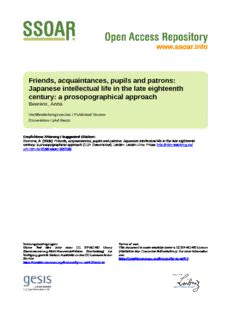
FRIENDS, ACQUAINTANCES, PUPILS, AND PATRONS Japanese intellectual life in the late ... PDF
Preview FRIENDS, ACQUAINTANCES, PUPILS, AND PATRONS Japanese intellectual life in the late ...
www.ssoar.info Friends, acquaintances, pupils and patrons: Japanese intellectual life in the late eighteenth century: a prosopographical approach Beerens, Anna Veröffentlichungsversion / Published Version Dissertation / phd thesis Zur Verfügung gestellt in Kooperation mit / provided in cooperation with: OAPEN (Open Access Publishing in European Networks) Empfohlene Zitierung / Suggested Citation: Beerens, A. (2006). Friends, acquaintances, pupils and patrons: Japanese intellectual life in the late eighteenth century: a prosopographical approach. (LUP Dissertaties). Leiden: Leiden Univ. Press. https://nbn-resolving.org/ urn:nbn:de:0168-ssoar-320183 Nutzungsbedingungen: Terms of use: Dieser Text wird unter einer CC BY-NC-ND Lizenz This document is made available under a CC BY-NC-ND Licence (Namensnennung-Nicht-kommerziell-Keine Bearbeitung) zur (Attribution-Non Comercial-NoDerivatives). For more Information Verfügung gestellt. Nähere Auskünfte zu den CC-Lizenzen finden see: Sie hier: https://creativecommons.org/licenses/by-nc-nd/4.0 https://creativecommons.org/licenses/by-nc-nd/4.0/deed.de A nna Beerens Friends, Acquaintances, Pupils and Patrons JAPANESE INTELLECTUAL LIFE IN THE LATE EIGHTEENTH CENTURY: A PROSOPOGRAPHICAL APPROACH LEIDEN UNIVERSITY PRESS FRIENDS, ACQUAINTANCES, PUPILS, AND PATRONS Japanese intellectual life in the late eighteenth century: a prosopographical approach Anna Beerens Leiden University Press Cover design: Randy Lemaire, Utrecht isbn 978 90 8728 001 7 nur 630 © Leiden University Press, 2006 All rights reserved. Without limiting the rights under copyright reserved above, no part of this book may be reproduced, stored in or introduced into a retrieval system, or transmitted, in any form or by any means (electronic, mechanical, photocopying, recording or otherwise) without the written permission of both the copyright owner and the author of the book. FRIENDS, ACQUAINTANCES, PUPILS, AND PATRONS Japanese intellectual life in the late eighteenth century: a prosopographical approach Proefschrift ter verkrijging van de graad van Doctor aan de Universiteit Leiden, op gezag van de Rector Magnificus Dr. D.D. Breimer, hoogleraar in de faculteit der Wiskunde en Natuurwetenschappen en die der Geneeskunde, volgens besluit van het College voor Promoties te verdedigen op maandag 22 mei 2006 klokke 15.15 uur door Anna Maria Josephina Josephus Beerens geboren te ’s-Hertogenbosch in 1957 Promotiecommissie: Promotor: Prof. Dr. W. J. Boot Referent: Prof. Dr. H. Bolitho (Harvard University, USA) Overige leden: Prof. Dr. M. F. M. Forrer Prof. Dr. W. R. van Gulik Prof. Dr. B. J. ter Haar Mw. Prof. Dr. R. Kersten Prof. Dr. B.C.A. Walraven Dr. J. J. de Jong (Universiteit Maastricht) Mw. Dr. M. Winkel Contents Foreword 7 Abbreviations 9 PART I: INTRODUCTION 13 1:Questions 15 2: Definitions 21 3: Method 36 PART II: PROSOPOGRAPHY 45 The prosopography 47 PART III: ANALYSIS 165 1: Age 167 2:Backgroundandmobility 179 3: Teachers and pupils 206 4:Sources ofincome 220 5:Activities 232 PART IV: A FRESH LOOK AT TOKUGAWA-PERIOD INTELLECTUAL LIFE 273 1: Intellectuals in the network 275 2: The Kansei Reforms 280 3: Intellectuals in society 288 B ibliography 293 1 Appendix 305 Table I: Sources of income 307 Table II:Activities 312 Foreword After a long career in classical ballet, I went to study Japanese language and culture at Leiden University. I was on the lookout for a new occupation in life, well-knowing that my knees would not always be up to the strain, but I did not at the time expect this to be a career in scholarship. Within the field of Japanology I have several interests, but it is not in fact surprizing that I have now spent several years in researching the lives of Japanese scholars and artists of the late eighteenth century of which this book is the result. From my own experience I know what it is to have a shijuku, a private academy, and what it means to handle culture as a commodity. And it is exactly these things that I have tried to highlight in my account of intellectual life of the late Tokugawa period. I would like to thank the following institutes for their support: NWO, het Leids Universiteits Fonds, and the Culture Communications Fund, especially Jascha Kraaipoel. I also thank the following individuals apart from those that the Leiden mores forbid me to mention: Timothy Clark (British Museum), Rudolf Dekker (Erasmus Universiteit, Rotterdam), Tom Harper (Tokyo), Jon de Jong (’s-Hertogenbosch), Kumakura Isao (National Museum of Ethnology, Osaka), B.J. Mansvelt Beck (Amsterdam), Steven Owyoung (St Louis Arts Museum), Marianne Thomeer (Leiden), and Ellis Tinios (University ofLeeds). Finally, I want to thank my former ballet pupils who have supported me in my choice even if it was against their own interests. My husband has been a great help: a severe critic and an indulgent hand at the computer. February120061 7
Description: